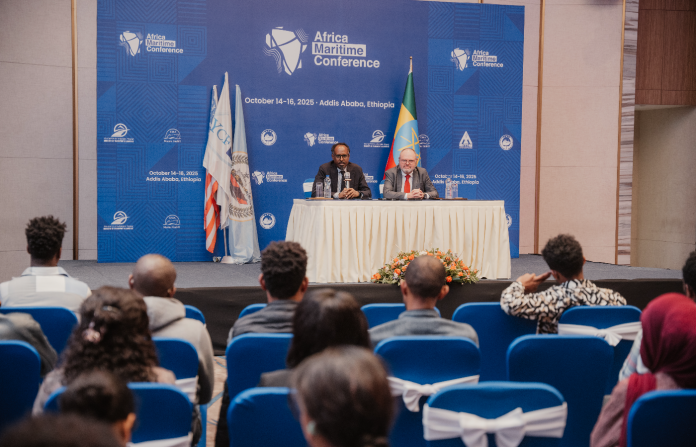Ethiopia has been selected to lead the formulation of Africa’s new ten-year maritime strategy, a plan aimed at positioning the continent as a competitive global player in the shipping and seafaring industry. The announcement was made on Monday in Addis Ababa during a press briefing ahead of the African Maritime Conference 2025, which opens later this week in the Ethiopian capital.
The conference, hosted by Ethiopia’s Ministry of Transport in collaboration with YCF Manning, a global maritime workforce development firm, will bring together key stakeholders including maritime academies, shipping lines, manning agents, and policymakers from across Africa and beyond. The discussions will center on how Africa can expand its maritime workforce, enhance global competitiveness, and capture greater economic value from the industry over the next decade.
According to organisers, the strategy, expected to be finalised by early 2026, will outline practical steps for developing human capital, harmonising training standards, and strengthening Africa’s position in global shipping routes. It will also provide a roadmap for integrating maritime education with broader trade and transport policies, linking sea-based industries with logistics, manufacturing, and energy.
Read also: EU postpones sustainability reporting rules for non-EU companies, easing pressure on global firms
Frans Joubert, Chief Executive of YCF Group, told reporters that Africa’s share of the global seafaring market remains disproportionately small despite its vast coastline and youth population. “Of the 1.9 million seafarers worldwide, Africa accounts for only four percent. With nearly 150 maritime academies operating across the continent, there is enormous untapped capacity,” he said.
Ethiopia, despite being landlocked, has emerged as a regional leader in maritime workforce development through the Ethiopian Maritime Training Institute (EMTI), which operates in partnership with international shipping companies. EMTI currently trains about 360 cadets, including 28 women, and maintains a placement rate above 95 percent, far exceeding Africa’s continental average of around 20 percent. Graduates serve aboard commercial vessels operated by leading global shipping lines, reflecting the program’s growing international recognition.
Joubert explained that each 1,000 trained officers generate roughly US$50 million in income through global placements, with cumulative earnings projected to surpass US$100 million as Ethiopia scales up training capacity. Cadets are recruited from 29 public universities, assessed for English proficiency and technical aptitude, and trained through a rigorous multi-year program combining classroom learning, shipboard experience, and competency certification under international maritime standards.
Read also: Senegal advances $5 billion refinery expansion to boost regional energy independence
Ethiopia’s progress has been supported by a strong ecosystem: government endorsement, regulatory oversight, and logistics infrastructure, including Ethiopian Airlines, which provides reliable global mobility for trainees and professionals. The country’s extensive diplomatic network, now among the largest in Africa, also facilitates international cooperation and seafarer deployment.
At the press briefing, Bahir Dar University President, Professor Mengesha Ayene, underscored that Africa’s maritime future depends not only on technical skills but on adaptability across disciplines. “Africa’s young population is its greatest advantage, yet the supply of trained maritime professionals remains far below demand. The new strategy broadens the scope beyond engineering to include training for hospitality, healthcare, and logistics roles at sea. This ensures a versatile workforce aligned with global industry needs,” he said.
Officials noted that the forthcoming African Maritime Strategy (2026–2036) will serve as a continental blueprint for workforce expansion, infrastructure integration, and sustainable resource management. It is expected to align with the African Union’s Agenda 2063 and the 2050 Africa’s Integrated Maritime Strategy (AIMS), both of which identify the blue economy as a major growth frontier for the continent.
Read also: Kenya, Tanzania, and Djibouti Ports compete for trade supremacy amid rising regional investments
Africa’s blue economy, covering shipping, fisheries, offshore energy, and coastal tourism, is currently valued at over US$300 billion annually and supports more than 50 million jobs. However, African nationals account for only a small fraction of the global maritime labour force. Stakeholders at the conference argue that this imbalance can be corrected through coordinated investment in training, technology, and institutional capacity.
Ethiopia’s leadership of the process is seen as strategic. Despite lacking a coastline, the country has invested heavily in maritime education since the early 2010s, viewing it as part of a broader strategy to develop export-oriented human capital. Its experience managing large-scale training programs, coupled with a reputation for engineering excellence, has made it a natural choice to coordinate continental planning efforts.
The African Maritime Conference 2025, taking place in Addis Ababa from October 14–16, will feature technical panels on workforce mobility, port digitisation, maritime finance, and sustainability in ship operations. Delegates are expected to produce a set of recommendations that will inform the first draft of the ten-year strategy.
The conference is also being viewed as a step toward formalising Africa’s role in the global maritime supply chain, where Europe and Asia currently dominate. With strategic ports in Djibouti, Mombasa, Durban, and Lagos, and growing demand for skilled seafarers worldwide, experts say the time is right for Africa to convert its demographic advantage into maritime capability.






